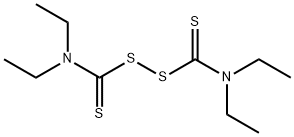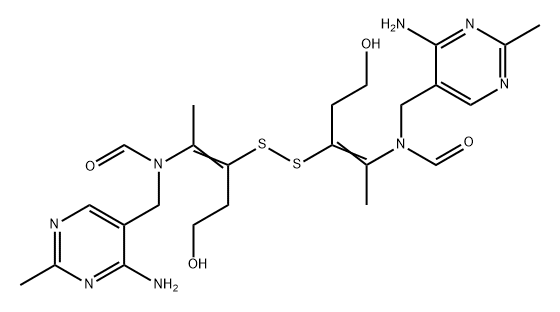Tetraethylthiuram disulfide , 97% , 97-77-8
Synonym(s):
Disulfiram;TETD;Tetraethylthiuram disulfide;DRAM;DRAM1
CAS NO.:97-77-8
Empirical Formula: C10H20N2S4
Molecular Weight: 296.54
MDL number: MFCD00009048
EINECS: 202-607-8
| Pack Size | Price | Stock | Quantity |
| 25G | RMB28.80 | In Stock |
|
| 100G | RMB48.80 | In Stock |
|
| 250g | RMB79.20 | In Stock |
|
| 500G | RMB158.40 | In Stock |
|
| 2.5KG | RMB668.80 | In Stock |
|
| others | Enquire |
PRODUCT Properties
| Melting point: | 69-71 °C (lit.) |
| Boiling point: | 117°C |
| Density | 1.27 |
| vapor pressure | 0Pa at 25℃ |
| refractive index | 1.5500 (estimate) |
| Flash point: | 117°C/17mm |
| storage temp. | 2-8°C |
| solubility | 0.004g/l |
| pka | 0.86±0.50(Predicted) |
| form | Crystals, Crystalline Powder or Granules |
| color | Light yellow |
| Odor | lt. gray powd., sl. odor |
| Water Solubility | 0.02 g/100 mL |
| Merck | 14,3364 |
| BRN | 1712560 |
| Exposure limits | ACGIH: TWA 2 mg/m3 NIOSH: TWA 2 mg/m3 |
| Stability: | Stable. Incompatible with strong oxidants. |
| InChIKey | AUZONCFQVSMFAP-UHFFFAOYSA-N |
| LogP | 3.6 at 21℃ |
| CAS DataBase Reference | 97-77-8(CAS DataBase Reference) |
| NIST Chemistry Reference | Disulfiram(97-77-8) |
| IARC | 3 (Vol. 12, Sup 7) 1987 |
| EPA Substance Registry System | Disulfiram (97-77-8) |
Description and Uses
Disulfiram was first synthesized in the 1800s to improve the manufacturing process of rubber. A physician working in a rubber factory plant first observed in 1937 that factory workers who were exposed to disulfiram were intolerant to ethanol. In the 1940s, two scientists rediscovered the disulfiram– ethanol effects while researching antiparasitic therapies. This finding eventually led to the approval of the medication to be used as an ethanol deterrent by the Food and Drug Administration in 1951.
Alcohol deterrent;Dopamine beta-hydroxylase inhibitor;For the treatment and management of chronic alcoholism.
Safety
| Symbol(GHS) |    GHS07,GHS08,GHS09 |
| Signal word | Warning |
| Hazard statements | H302-H317-H373-H410 |
| Precautionary statements | P273-P280-P301+P312+P330-P302+P352-P314 |
| Hazard Codes | Xn,N |
| Risk Statements | 22-43-48/22-50/53 |
| Safety Statements | 24-37-60-61 |
| OEB | B |
| OEL | TWA: 2 mg/m3 [Precautions should be taken to avoid concurrent exposure to ethylene dibromide.] |
| RIDADR | UN 3077 9/PG 3 |
| WGK Germany | 3 |
| RTECS | JO1225000 |
| TSCA | Yes |
| HazardClass | 9 |
| PackingGroup | III |
| HS Code | 29303000 |
| Hazardous Substances Data | 97-77-8(Hazardous Substances Data) |
| Toxicity | LD50 orally in rats: 8.6 g/kg (Child, Cramp) |




